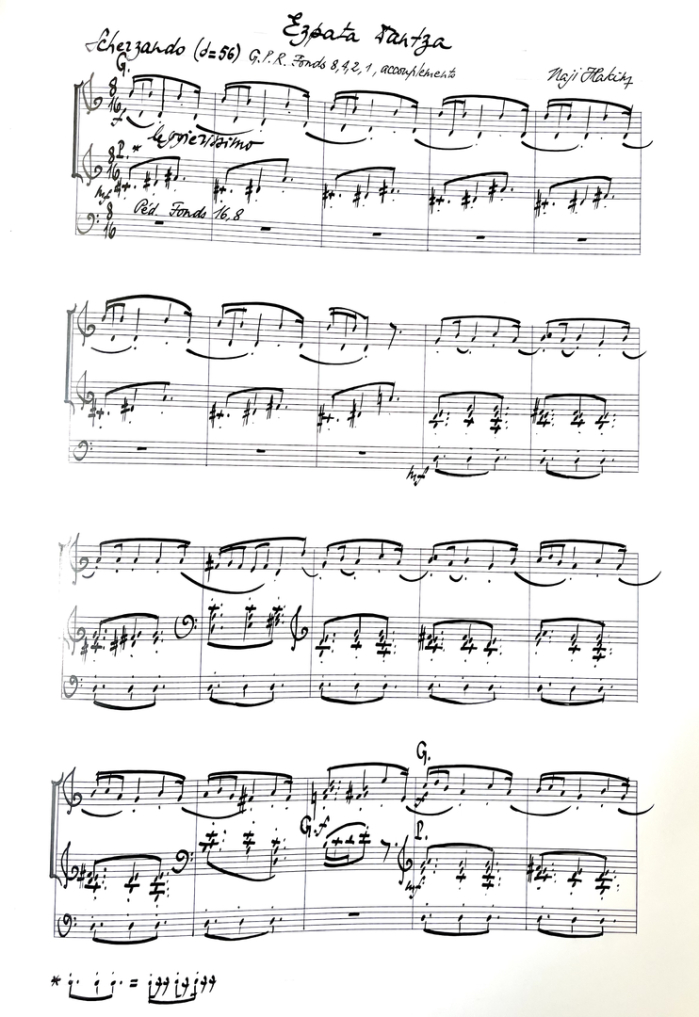
2. Ezpata Dantza
Title, Duration, Place, Year, Publisher, Dedicated to, Premiere (performer(s), place, date)
. EZPATA DANTZA, second of the Trois Danses Basques, 4', Chatou, 2012, Schott, à mon fils Jean-Paul, Naji Hakim, Pfarre Herz Jesu, Graz, Austria, 01.05.13
This is the original version of Naji Hakim's Ezpata Dantza, second of Trois Danses Basques for orchestra
EZPATA DANTZA
Sword Dance
Danza de espadas
Danse de l’épée
A mon fils Jean-Paul
The sword symbolizes the solar power and the generating energy. By symbolic homonymy, the composer chose the key of G major to figure the Christ. The ezpatadantza comes from the region of Durango and is danced in front of the authorities and at the feast of Corpus Christi, during the mass, in front of the Holy Sacrament.
Naji Hakim’s Espata Dantza plays on the alternation between a ritornello and a light theme full of joy. The 8/16 barring is divided into two unequal beats : 8 + 3 = 5. The bouncing character arises from the 6th beat’s anacrusis impulse that should be slightly accentuated.
La espada simboliza la fuerza solar y significa una energía generadora. Por homonimia simbólica, el compositor escoge la tonalidad de sol mayor que es la imagen sonora de Cristo. La ezpatadantza proviene de la región de Durango y se baila delante de las autoridades así como en la fiesta del Corpus durante la misa, frente al Santísimo Sacramento.
La Espata Dantza de Naji Hakim se basa sobre la alternancia entre un estribillo y un tema ligero y lleno de alegría. El compás a 8/16 se articula en dos tiempos desiguales : 8 = 5 + 3. El carácter festivo deriva del impulso en anacrusis del 6° tiempo que se debe acentuar ligeramente.
L'épée symbolise la force solaire et l’énérgie génératrice. Par homonymie symbolique, le compositeur choisit la tonalité de sol majeur pour figurer le Christ. La ezpatadantza vient de la région de Durango et se danse devant les autorités et à la fête du Corpus Christi, pendant la messe, face au Saint-Sacrement.
L’Espata Dantza de Naji Hakim joue sur l’alternance entre une ritournelle et un thème léger et plein de joie. La mesure à 8/16 s’articule en 2 temps inégaux : 8 = 5 + 3. Le caractère enlevé découle de l'élan anacrousique du 6e temps qu’on accentuera légèrement.
Ezpata eguzkiaren indarraren sinboloa da eta indar-sortzailea adierazten du. Homonimia era sinbolikoan, konpositoreak sol nagusiko tonalitatea aukeratzen du, Kristoren doinuzko irudia delarik. Ezpata-dantza jatorriz Durango ingurukoa da eta agintarien aurrean eta baita Gorpuzti eguneko mezan, Sakramentu Santuaren aurrean, dantzatzen da.
Naji Hakim-en Ezpata-dantzak, leloa eta gai arin eta alaia, tartekatzen ditu. 8/16-ko konpasa bi aldi desberdinetan banatzen da: 8 = 5 + 3. Seigarren aldiko anakrusis moduko bultzadak ematen dio festa izaera, nabarmendu egin beharrekoa.
Marie-Bernadette Dufourcet
Translation in Basque by Jaione Lizarazu

